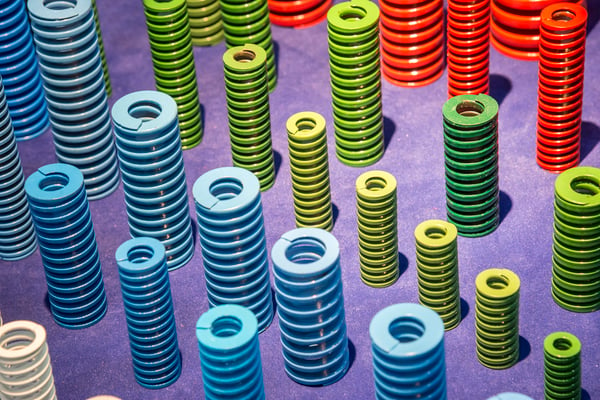
There are many ways to make something go from point A to point B. Not all of them are great long-term solutions.
You’ve probably worked with (or at least heard of) gas springs for a long time. But while these springs provide tremendous force, they can fail, leak, or otherwise hamper your end product -- or even its users’ safety.
What happens then? As the manufacturer of the product, it turns to you to find a solution. This blog post will teach you how to replace gas springs with mechanical springs to make your product more efficient and safer.
What Are Gas Springs?
The gas spring that people are probably most familiar with are those used to control the motion of vehicle trunk doors. However, gas springs are used in many other applications too, mainly to lift a lid in a smooth manner.
The basic gas spring design is simple: A tube with an internal piston is filled with compressed gas, and further compression or decompression moves a shaft at the end of the piston. The larger the gas spring and the greater the compression rate, the more force it can exert.
Helpful tip: How to adjust gas springs -- Gas springs operate via pneumatics, so the compression rate depends on the amount of fluid within the cylinder. To release some of the pressure in the spring, use the built-in valve to let some of the lubricants out.
What Are Gas Springs Used For?
Gas springs are commonly used for lid hinges, in applications such as:
- Car trunks
- Medical equipment (slide preparation devices, cryogenic freezers, and centrifuges)
- Deli cases and food prep tables
- Toolboxes
- Boat engine covers
- Industrial equipment
- Scientific/laboratory machines
A top reason to use a gas spring is the price. They can be a more affordable option when used for consumer products or instances where they can be mass-produced, like for car trunks, boat engine covers, and toolboxes.
However, there are several downsides to gas springs. They can present safety issues in medical and food prep settings because lubricant could leak if there are cracks in the cylinder, risking contamination.
Medical equipment that uses gas springs typically goes through extensive daily use (such as a centrifuge). Gas springs can experience failure due to unsatisfactory cycle life. Having springs fail in medical settings can be dangerous for workers and detrimental to test results.
Incorporating spring-loaded hinges or counter-balance hinges can drastically reduce the risk of contamination or complete failure. For more on heavy-duty hinges, check out the free resource below:
Signs to Replace Gas Springs
Gas springs typically don’t suddenly stop working; there are signs that they’re approaching failure.
One such sign, as mentioned before, is leaking lubricant. Depending on the stress created by the application or the spring’s age, cracks may form along the pneumatic tube. Worn seals can also cause the tube to lose lubricant. Loss of lubricant can affect the compression rate and drastically impact performance.
Additionally, you may experience chronic problems with fluctuating indoor or outdoor temperatures. The gas spring may pop the lid up unexpectedly in a hot environment, or cause the lid to sag in colder temperatures. This issue is common in car trunks.
Lastly, and most importantly, is the risk of complete failure. When the lid doesn’t stay open when the user lets go, the gas spring may have reached the end of its life cycle.
Making the Switch to Mechanical Springs
While mechanical springs can be a bit pricier than gas springs, they offer major advantages. These springs operate using coils that are compressed, extended, or twisted to provide force -- say goodbye to messy gas tubes!
Mechanical hinges offer a wide range of movement, come in various sizes to accommodate space requirements, and provide greater safety than gas springs.
When considering making the switch to a mechanical spring, here are some factors to discuss with a manufacturer:
- Weight of the lid
- Desired materials
- Center of gravity for the lid
- Environmental factors (heat, cold, water, salt, sand, etc.)
- Level of corrosion resistance required
- Available space
- Life cycle requirements
Other factors to discuss include any problems with the previous hinge and how you want to mitigate future issues. By discussing these factors with a hinge manufacturer, it’ll have a clearer understanding of your needs and what has to go into your next mechanical hinge design.
A hinge manufacturer that doubles as a design assistant can provide the right recommendations as to which springs will work best for your design needs and price range.
Let’s Get to Work
Mechanical hinges are better for industrial and medical applications because they’re safer and provide greater lid support. Actually, mechanical hinges are better for almost every application.
If you’re interested in learning more about how to replace gas springs with mechanical hinges, reach out to our team of engineers. Whether you have a brand-new design in mind or are making changes to an old piece of equipment, mechanical springs can almost certainly help.
(Editors Note: This blog was originally published in October 2020 and was updated in August, 2021)
.png?width=12000&height=2033&name=WeberKnappLogo_white%20(1).png)



